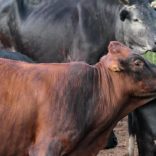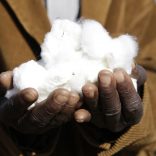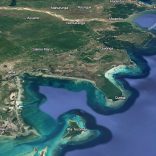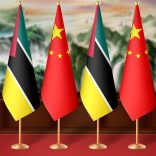Agreement signed for Mozambique to host SADC Fisheries Monitoring Centre in KaTembe
Mozambique: Mopeia to have irrigation systems powered by national electric grid and solar energy

Photo: O País
The Mozambican government and the World Bank are investing US$2.7 million in an irrigation system powered by the national grid and solar panels in three of the four irrigated areas in Mopeia district, in the central province of Zambézia.
Just over 400 farmers are producing rice in the four irrigation fields located near the district headquarters town of Mopeia, over an area estimated at 365 hectares. The farmers are excited over the expected boost in production, but concerned about finding markets.
Catija Cebola, who produces rice on the irrigated land, has four hectares and is dedicated to producing the Simão, Macassane and Chupa varieties of rice. She says that the introduction of irrigation increases production, but the challenge is finding a market to sell the rice.
“Before, we used to produce on dry land and the production levels per hectare varied between two and 2.5 tons. Today, with irrigation, the levels have increased to up to four tons. We are producing a lot of rice, but unfortunately we have no market to sell our surplus,” said Catija, adding that the little she manages to sell is to people looking for small quantities.
Florência Soares, another member of one of the rice farmers associations, is producing on a total of two hectares. She said that under the dry land regime she would produce an average of 2.5 tons per hectare and with the irrigation system installed, she is also producing four tons. The issue of the market is the main headache for these small-scale farmers.
“What worries us is that the few people who seek our rice are the ones who decide the prices. We work hard to produce rice, but when it comes to prices, the buyer is the one who dictates,” said Florencia, requesting support for farmers so that they can profit from their production.
Currently, the district of Mopeia has four irrigated areas, three of which are well-structured and one is dryland.
The district director of economic activities in Mopeia says that the quantity of rice in the first season exceeded expectations. As he explained, “initially, we expected to harvest 30,000 tons, but the number could reach 40,000. However, our agenda is to work towards safeguarding the interests of the farmers”.
For Gilton José, the challenge is to make the production chain and a public-private consortium work to facilitate access to the market.
“The consortium in question involves institutions such as the National Irrigation Institute (INIR), the Mozambican Almond Institute (IAM) and the Adventist Development, Resources and Relief Association (ADRA), where we have a memorandum that will be signed within a few days and which aims to facilitate market connections. We are certain that the concerns raised by producers about the lack of a market are numbered, as we believe that the boundaries for absorbing the product have been created,” José said.
The Director of the National Irrigation Institute, Delfim Vilissa, says that the government and partners are making serious investments in the rice sector. The challenge now is to install solar panels to operate the electric pumps in order to reduce operating costs.
“As you can imagine, energy is expensive, and most producers do not have the purchasing power, so there is an urgent need to seek sustainable alternatives from an economic and ecological point of view. In this context, we have introduced solar panels as a pilot project that are contributing to the irrigation of 100 hectares in the Chiverano irrigated area, and this technology allows us to save around 90% on electricity costs,” Vilissa said.
At a national level, irrigation remains a challenge, despite efforts in this regard. Of the 180,000 hectares already equipped with infrastructure nationwide, Zambézia has 1,000.












Leave a Reply
Be the First to Comment!
You must be logged in to post a comment.
You must be logged in to post a comment.